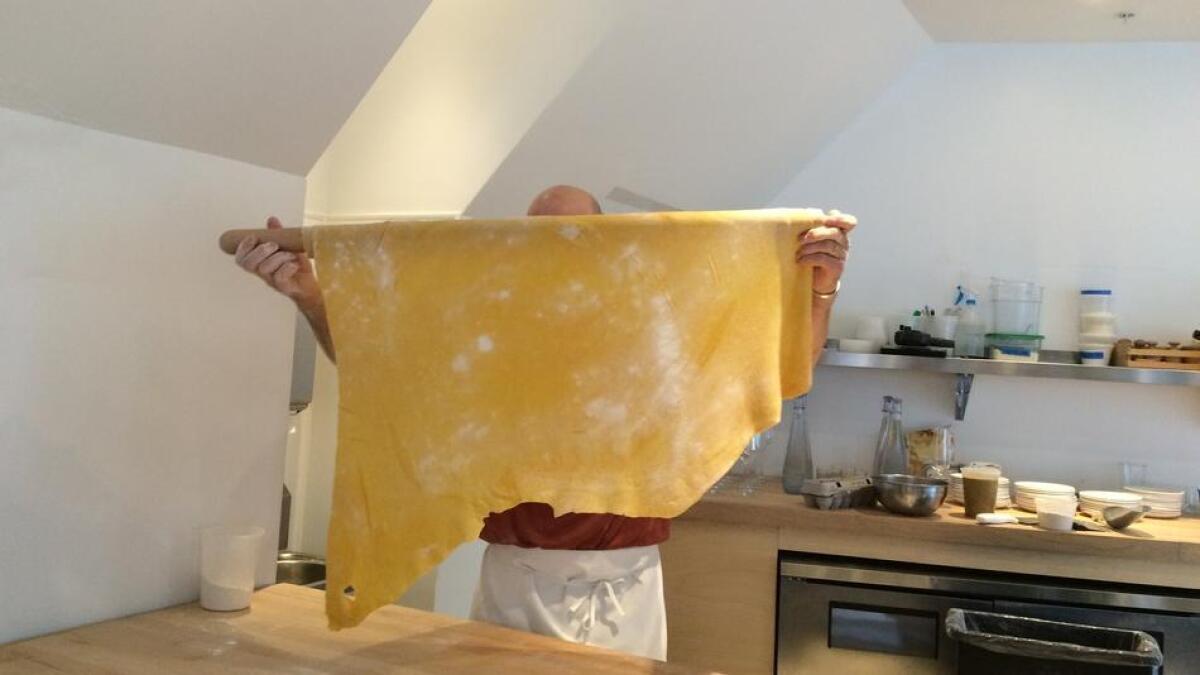Chef Marc Vetri does a pasta demo at Bucato

- Share via
Marc Vetri, the Sicilian-American chef behind Vetri in Philadelphia, rolled into town this week to promote his new book “Mastering Pasta: The art and Practice of Handmade Pasta, Gnocchi, and Risotto” with a demonstration and pasta seminar at Bucato in Culver City.
It’s worth noting that Vetri and Bucato chef-owner Evan Funke may be the only two chefs in America making pasta entirely by hand, using only their hands and a mattarello, or long wooden rolling pin.
It all happens upstairs in Bucato’s serene all-white pasta-making room outfitted with three long wooden tables. Vetri had brought his own heirloom Red Fife flour, which he’d milled at his restaurant in Philadelphia before getting on the plane.
Pouring the ivory flour onto a table, he talked about how, once he discovered that flour could have different flavors like wine, it changed everything for him. He now really considers what texture and flavor he wants a certain pasta to have and how to achieve that with a mix of flours and by adjusting the proportion of egg yolks to whole eggs.
To his Red Fife flour, Vetri added a touch of finely milled 00 flour from Italy, a little durum flour, and a little wholewheat he’d milled himself. Gathering the flours into a mound, he made a well in the center, and broke in the eggs, using mostly egg yolks. And, with his index finger, began to stir always in the same direction, slowly incorporating the flour into the eggs.
You don’t really need a recipe, Vetri says. The eggs will absorb as much flour as they need. He cautioned against making the dough too dry, though. You want it hydrated. Flouring the table again, he gathered up the bits of dough into a ball and began kneading it by hand. Put your whole body into the motion.
Normally, he’d wait 30 minutes before rolling out the dough, to allow it time to absorb the water and relax. But for this afternoon, he’s moving straight from kneading to rolling out. Using that giant rolling pin, he works the dough, rolling it thinner and thinner with each turn. Now you can see its deep gold color and soon the sheet of pasta practically covers the entire table.
How thin should it be?
Thin enough to read through. Vetri holds up the sheet of dough so we can see his hands through it.
He moves quickly now, rolling up the sheet of dough loosely and cutting it into 3/4-inch strips for pappardelle. Then he’s off to the service kitchen around the corner to make a mushroom sauce with morels, onions and butter. That’s it. The noodles have bounce and a robust flavor that works beautifully with the soft plush of the morels and the sweet flecks of onion.
Actually, the day is a kind of homecoming for Vetri. From 1990 to 1994, he lived in Venice and cooked for Wolfgang Puck at Granita, trying his hand at every station, including pasta. That was just before he set off for Italy to work at restaurants and with a pasta maker there.
Piero Selvaggio writes in the forward to Vetri’s first book, “Il Viaggio di Vetri: a Culinary Journey,” how the young chef called him up and said he wanted to go to Italy per fare esperienza (for the experience). Selvaggio hooked him up with contacts and restaurants where he could work. And when he’d had his experience in Italy, Vetri came back to his native Philadelphia to open Vetri in 1998.
Follow @sirenevirbila on Twitter for more on food and wine.
More to Read
Eat your way across L.A.
Get our weekly Tasting Notes newsletter for reviews, news and more.
You may occasionally receive promotional content from the Los Angeles Times.










